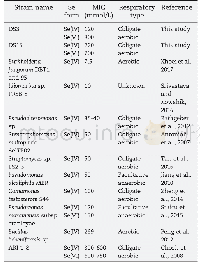《Table 3–Minimal inhibitory concentrations (MICs) of selenite and/or selenate for partial selenium t
 提示:宽带有限、当前游客访问压缩模式
提示:宽带有限、当前游客访问压缩模式
本系列图表出处文件名:随高清版一同展现
《Two selenium tolerant Lysinibacillus sp. strains are capable of reducing selenite to elemental Se efficiently under aerobic conditions》
It has been shown that phylogenetically diverse microbes including bacteria,archaea and fungi are able to reduce Se oxyanions to non-toxic elemental Se under aerobic or anaerobic conditions(Güven et al.,2013;Lampis et al.,2017;Lindblom et al.,2014).It is interesting that the selenite-reducing bacteria are mainly from the phyla of Proteobacteria,Firmicutes and Antinomycetes(Avenda?o et al.,2016;Lampis et al.,2014;Tan et al.,2016).A possibility is that bacteria from these phyla are abundant in thiol-containing compounds which play important role in the reduction of selenite.However,most microbes could not resist high concentration of Se.In this study,two bacterial strains which belong to Lysinibacillus genus were isolated from Se-rich soil at tea orchard.Both strains showed extremely higher tolerance to selenate and selenite compared with other bacteria in most previous studies with the exception of Bacillus licheniformis sp.and ARI 1–8(Table 3),which were both isolated from Se contaminated environments(Ghosh et al.,2008;Peng et al.,2012).In general,the phenotypic features and metabolic pathways of microbes are highly dependent on the environment they live in and the substances they use(Peng et al.,2016).The microbes with MICs higher than 50 mmol/L listed in Table 3are mostly isolated from Se-rich environments or antimony mine contaminated by multiple metal(loid)s(Zheng et al.,2014).Pseudomonas alcaliphila MBR,a facultative anaerobe separated from the biofilm of nitrifying bioreactor,is an exception.It has the potential to reduce nitrate to nitrite and ammonium under aerobic conditions(Jiang et al.,2010).The high Se tolerance is therefore speculated to be concerned with nitrite reductase that is also active in selenite reduction(Nancharaiah and Lens,2015).In contrast,the tolerance of Burkholderia fungorum and Idiomarina sp.collected either from oil refinery drainage and inner tissues of hybrid poplar or estuary soil was relatively low(Khoei et al.,2017;Srivastava and Kowshik,2016).Therefore,although the ability to reduce Se oxyanions is almost ubiquitous in microbes,Se stress seems to be necessary to evolve a high Se tolerance.
| 图表编号 | XD0033520800 严禁用于非法目的 |
|---|---|
| 绘制时间 | 2019.03.15 |
| 作者 | Ju Zhang、Yue Wang、Zongyuan Shao、Jing Li、Shuting Zan、Shoubiao Zhou、Ruyi Yang |
| 绘制单位 | College of Environmental Science and Engineering, Anhui Normal University、College of Environmental Science and Engineering, Anhui Normal University、College of Environmental Science and Engineering, Anhui Normal University、College of Environmental Science |
| 更多格式 | 高清、无水印(增值服务) |
查看“Table 3–Minimal inhibitory concentrations (MICs) of selenite and/or selenate for partial selenium tolerant bacteria comp”的人还看了
-

- Table 1 Effects of different concentrations of A.flavus conidial suspension on the disease level and resistance ability
-

- Table 6Minimum inhibitory concentrations (MIC50) and minimal fungicidal concentrations (MFC) of organic fractions obtain
-

- Table 7Inhibition halos, minimum inhibitory concentrations (MIC50) and minimal bactericidal concentrations (MBC) of the





